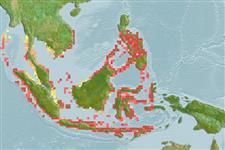Actinopterygii (ray-finned fishes) >
Syngnathiformes (Pipefishes and seahorses) >
Syngnathidae (Pipefishes and seahorses) > Hippocampinae
Etymology: Hippocampus: Greek, ippos = horse + Greek,kampe = curvature (Ref. 45335).
Environment / Climate / Range
Ecology
Marine; reef-associated; non-migratory; depth range 15 - 30 m (Ref. 90102). Tropical, preferred ?; 15°N - 10°S, 91°E - 128°E
Western Central Pacific: Malaysia, Thailand, Singapore, Viet Nam, Indonesia and Philippines. Confused with Hippocampus kuda. International trade is monitored through a licensing system (CITES II, since 5.15.04) and a minimum size of 10 cm applies.
Length at first maturity / Size / Weight / Age
Maturity: Lm 8.1 range ? - ? cm
Max length : 18.7 cm OT male/unsexed; (Ref. 52034)
Length type refers to Height (= from top of coronet to the tip of straightened tail). This species is mainly found in pairs (Ref. 48635) on coral reefs, sponge gardens, kelp, and floating Sargassum. Nocturnal, site faithful. Feeds on zooplankton (Ref. 85309). Ovoviviparous (Ref. 205). The male carries the eggs in a brood pouch which is found under the tail (Ref. 205). Life span probably more than 2-3 years. Used for traditional Chinese medicine (Ref. 85309).
Monogamous mating is observed as both obligate and genetic (Ref. 52881). Male carries the eggs in a brood pouch (Ref. 205). Gestation period 2-3 weeks (but varies with water temperature) (Ref. 30915).
Lourie, S.A., A.C.J. Vincent and H.J. Hall, 1999. Seahorses: an identification guide to the world's species and their conservation. Project Seahorse, London. 214 p. (Ref. 30915)
IUCN Red List Status (Ref. 115185)
Threat to humans
Harmless
Human uses
Fisheries: commercial; aquarium: commercial
More information
ReferencesAquacultureAquaculture profileStrainsGeneticsAllele frequenciesHeritabilityDiseasesProcessingMass conversion
Tools
Special reports
Download XML
Internet sources
